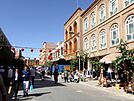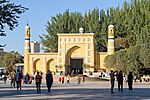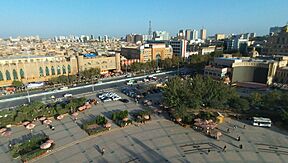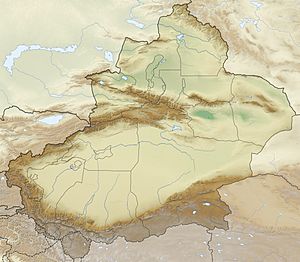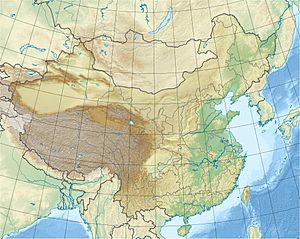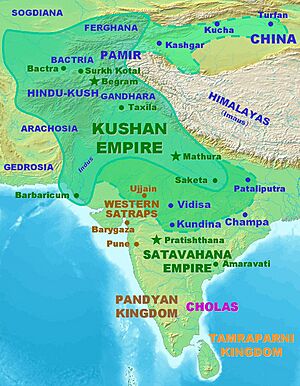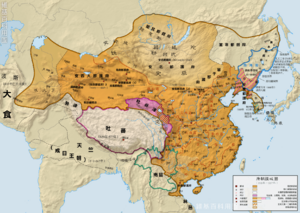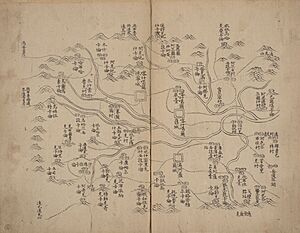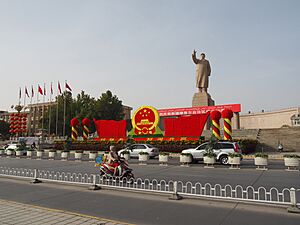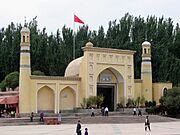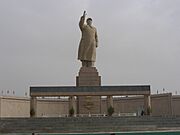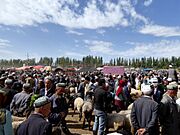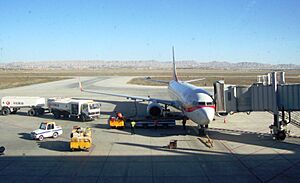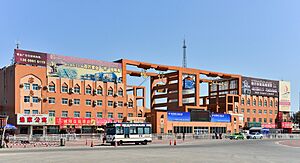Kashgar facts for kids
Quick facts for kids
Kashgar
Kashi
|
|
|---|---|
|
County-level city
|
|
|
Afaq Khoja Mausoleum
Kashgar Old City
Id Kah Mosque
Skyline of Kashgar
|
|
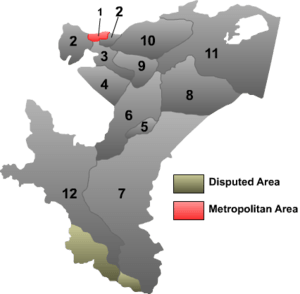
Location of Kashgar (red) within Kashgar Prefecture
|
|
| Country | China |
| Autonomous region | Xinjiang |
| Prefecture | Kashgar |
| Municipal seat | Östeng Boyi Subdistrict |
| Area
(2018)
|
|
| • County-level city | 1,056.8 km2 (408.0 sq mi) |
| • Urban | 130 km2 (50 sq mi) |
| • Metro | 2,818 km2 (1,088 sq mi) |
| Elevation | 1,270 m (4,170 ft) |
| Population
(2020)
|
|
| • County-level city | 782,662 |
| • Density | 740.60/km2 (1,918.14/sq mi) |
| • Urban | 920,000 |
| • Urban density | 7,080/km2 (18,300/sq mi) |
| Demographics | |
| • Major ethnic groups |
|
| Time zones | UTC+08:00 (CST) |
| UTC+06:00 (XJT, de facto) | |
| Postal code |
844000
|
| Area code(s) | 0998 |
| GDP (Nominal) | 2019 |
| – Total | CN¥22.8 billion US$3.3 billion |
| – Per capita | CN¥34,748 US$5,028 |
| – Growth | |
| Kashgar | |||||||||||||||||||||
|---|---|---|---|---|---|---|---|---|---|---|---|---|---|---|---|---|---|---|---|---|---|

"Kashgar" in Uyghur Arabic (top) and Chinese characters (bottom)
|
|||||||||||||||||||||
| Uyghur name | |||||||||||||||||||||
| Uyghur | قەشقەر | ||||||||||||||||||||
|
|||||||||||||||||||||
| Chinese name | |||||||||||||||||||||
| Chinese | 喀什 | ||||||||||||||||||||
| Hanyu Pinyin | Kāshí | ||||||||||||||||||||
|
|||||||||||||||||||||
| Alternative Chinese name | |||||||||||||||||||||
| Simplified Chinese | 喀什噶尔 | ||||||||||||||||||||
| Traditional Chinese | 喀什噶爾 | ||||||||||||||||||||
| Hanyu Pinyin | PRC: Kāshígá'ěr ROC: Kàshígé'ěr |
||||||||||||||||||||
|
|||||||||||||||||||||
| Historical Chinese name | |||||||||||||||||||||
| Chinese | 疏勒 | ||||||||||||||||||||
| Hanyu Pinyin | Shūlè | ||||||||||||||||||||
|
|||||||||||||||||||||
| Second historical Chinese name | |||||||||||||||||||||
| Chinese | 疏附 | ||||||||||||||||||||
| Hanyu Pinyin | Shūfù | ||||||||||||||||||||
|
|||||||||||||||||||||
Kashgar (Uyghur: قەشقەر) or Kashi (Chinese: 喀什) is a city in the Tarim Basin region of southern Xinjiang, China. It is one of China's westernmost cities. Kashgar is located close to the borders with Kyrgyzstan and Tajikistan.
For over 2,000 years, Kashgar was a very important oasis city on the famous Silk Road. This ancient trade route connected China with the Middle East and Europe. Kashgar is considered one of the oldest cities in the world where people have lived continuously.
Today, Kashgar has a population of about 711,300 people (as of 2019). The city's main area covers about 15 square kilometers. However, its full administrative area is much larger, extending over 555 square kilometers.
Throughout history, Kashgar has been ruled by many different groups. These include Chinese, Turkic, Mongol, and Tibetan empires. The city has also seen many battles between different groups from the steppes.
Currently, Kashgar is managed as a county-level city. It is the main city of Kashgar Prefecture. This prefecture covers a huge area of 162,000 square kilometers and has about 4 million people (as of 2010).
In 2010, Kashgar was named a Special Economic Zone. It is the only city in western China with this special status. Kashgar is also the end point of the Karakoram Highway. This highway is a big part of the China–Pakistan Economic Corridor, a huge project worth billions of dollars.
Contents
Understanding the Name of Kashgar
The earliest names for the city were Shufu and Shule. Shufu was the name for Kashgar's old city, where the Uyghur people lived. Shule was the name for a new city built by Han Chinese settlers. This new city was about 6 kilometers from the old one.
The name Shule might have been the Chinese way of writing the Sanskrit name for Kashgar, which meant "fortunate hospitality."
The exact origin of the name Kashgar is not fully known. It is still a topic that experts discuss. A Roman geographer named Ptolemy (who lived from 90–168 AD) called the city Kasi in his book Geography. A Buddhist scholar named Xuanzang recorded the name Kasha in 644 AD after visiting the city.
The name Kashgar first appeared in Chinese records during the Song dynasty (960–1279 AD). However, people probably used this name when speaking long before it was written down.
The English name Kashgar comes from the Russian name, which itself came from the Persian name Kâšğar. An English scholar named H. W. Bailey suggested that Kâš might have been the original name of the city. The suffix -ğar (meaning "mountain") was added later.
Today, the modern Chinese name is Kashi. This is a shorter version of the longer name Kashiga'er. The Chinese government's official spelling for Kashgar in the Uyghur language is Qeshqer.
Kashgar's Long History
Kashgar has always been a meeting point for many different cultures and empires. It has been ruled by Chinese, Turkic, Mongol, and Tibetan empires. The city has also seen many battles between different groups of people.
Early History: Han Dynasty and Beyond
The first time Kashgar is mentioned is when a Chinese Han dynasty envoy traveled the Northern Silk Road. This was to explore lands to the west.
The Book of Han tells us that around 76 BCE, the Chinese conquered several states in the Tarim Basin, including Sulei (Kashgar). Before Islam arrived, the people of Kashgar practiced Zoroastrianism and Buddhism.
The population of Kashgar grew over time. The Book of Han (covering 125 BCE to 23 CE) recorded 1,510 households and 18,647 people. By the time of the Book of the Later Han (25 to 170 CE), it had grown to 21,000 households.
| Year | City Name | Dynasty | Notes |
|---|---|---|---|
| ≈ 2nd cent. BC |
Shule | Shule Kingdom | |
| ≈ 177 BC | Xiongnu | ||
| 60 BC | Western Han dynasty | ||
| 1st cent. AD |
Xiongnu, Yuezhi | ||
| 74 | Eastern Han dynasty | ||
| 107 | Northern Xiongnu | ||
| 127 | Eastern Han dynasty | ||
| 150 | Kushan | ||
| 323 | Kucha, Rouran | ||
| 384 | Former Qin | ||
| ≈450 | Hephthalite Empire | ||
| 492 | Gaoche | ||
| ≈504 | Hephthalite Empire | ||
| ≈552 | First Turkic Khaganate, | ||
| ≈583 | Western Turkic Khanate, | ||
| 648 | Tang dynasty | ||
| 651 | Western Turkic Khanate, | ||
| 658 | Tang dynasty | ||
| 670 | Tibetan Empire | ||
| 679 | Tang dynasty | ||
| 686 | Tibetan Empire | ||
| 692 | Tang dynasty | ||
| 790 | Tibetan Empire | ||
| 791 | Uyghur Khaganate | ||
| 840 | Kashgar | Karakhanid Khanate | |
| 893 | |||
| 1041 | Eastern Karakhanid | ||
| 1134 | Karakhitai Khanate (Western Liao dynasty) |
||
| 1215 | |||
| 1218 | Mongol Empire | ||
| 1266 | Chagatai Khanate | ||
| 1348 | Moghulistan (Eastern Chagatay) |
||
| 1387 | |||
| 1392 | Timurid dynasty | ||
| 1432 | Chagatay | ||
| 1466 | Dughlats | ||
| 1514 | Yarkent Khanate | ||
| 1697 | Dzungar Khanate | ||
| 1759 | Qing dynasty | ||
| 1865 | Emirate of Kashgaria | ||
| 1877 | Qing dynasty | ||
| 1913 | Republic of China | ||
| 1933 | Turkic Islamic Republic of East Turkestan | ||
| 1934 | Republic of China | ||
| 1949 | Kashgar / Kashi | People's Republic of China | |
| Capital of an independent political entity | |||
The Book of the Later Han also mentions the Kushan Empire's involvement in Kashgar. It tells a story about a king of Shule (Kashgar) who was exiled to the Kushans. Later, the Kushans helped him return to power. This made Kashgar strong and a rival to other kingdoms.
Kashgar Under the Tang Dynasty
The Tang dynasty began in 618 AD. This started a long fight between China and the Western Turks for control of the Tarim Basin. In 635 AD, the Tang records mention an envoy from Kashgar's king visiting the Tang capital.
The Buddhist scholar Xuanzang visited Kashgar in 644 AD. He noted that Buddhism was very active there. Xuanzang described Kashgar as having many crops, fruits, and flowers. He also said they wove fine woolen goods and rugs.
Around the same time, Nestorian Christians also established churches in Kashgar.
The Tang dynasty eventually defeated the Western Turk tribes. They took control of the Tarim Basin kingdoms, including Kashgar, by 658 AD. However, the Tibetans later gained control of Kashgar from 676-692 AD. The Tang dynasty then regained control for the next fifty years.
In 751 AD, the Chinese were defeated by an Arab army in the Battle of Talas. This battle, along with the An Lushan Rebellion, caused Tang influence in Central Asia to decline.
The Arrival of Islam
In 711 AD, the Arabs invaded Kashgar. Some say that Qutayba ibn Muslim conquered Xinjiang between 712-715 AD. Even though the Muslim religion faced challenges at first, it slowly gained influence in the region.
However, Islam was not fully established in Kashgar until the 10th century. This happened under the Kara-Khanid Khanate.
Turkic and Mongol Rule
The Kara-Khanid Khanate was formed by tribes like the Karluks and Yaghmas. The Karakhanid ruler Sultan Satuq Bughra Khan converted to Islam in the 10th century and captured Kashgar. Kashgar was the capital of the Karakhanid state for a while.
Later, the Karakhanid Khanate split into two parts. Kashgar became part of the Eastern Karakhanid state. In the 12th century, both Karakhanid states were defeated by the Kara-Khitans. However, Karakhanid rule continued in Kashgar under the Kara-Khitans. The Kara-Khitan rulers allowed different religions, so Islamic life continued.
The Kara-Khitai were then conquered by Genghis Khan in 1219. After Genghis Khan's death, Kashgar came under the rule of the Chagatai Khans. Marco Polo visited the city around 1273-1274. He noted that many Nestorian Christians lived there and had their own churches.
In the 14th century, a Chagatai khan named Tughluq Timur converted to Islam. This led to Islam becoming more important in the region again.
In 1389-1390, Tamerlane attacked Kashgar. The city faced many problems. In 1514, a new fort was built with strong defenses. The Chagatai Khans' rule ended in 1572. Then, two powerful groups, the White and Black Mountaineers, fought for control. The Dzungar Khanate eventually conquered Kashgar and made the Khoja leaders their puppets.
Qing Dynasty Control
The Qing dynasty defeated the Dzungar Khanate in 1759 and took control of Kashgar. They brought other ethnic groups to live near a Manchu army base to strengthen their power.
There were rumors that the Qing planned to expand further. The leaders of nearby areas asked the Afghan king Ahmed Shah Abdali for help. However, the Qing expansion did not happen.
The Qing continued to rule Kashgar, though there were occasional revolts by the Afaqi Khojas. One major revolt happened in 1827, when Jahanghir Khoja took the city. But the Qing general regained control in 1828.
Another revolt in 1829 led to special trade rights for Muslims in the area. The region was mostly peaceful until 1846. Then, a new Khoja revolt under Kath Tora briefly took control of the city. The last Khoja revolt was in 1857, led by Wali-Khan.
The Dungan Revolt and Yakub Beg
The Dungan Revolt (1862–1877) was a rebellion by various Muslim groups. It started in 1862 and quickly spread.
In August 1864, Dungan troops in Yarkand killed many Chinese people. The people of Kashgar also rebelled. They asked for help from a Kyrgyz leader, Sadik Beg. He was joined by Buzurg Khan and his general Yakub Beg.
Sadik Beg soon regretted asking for a Khoja. He marched against Kashgar, which was now controlled by Buzurg Khan and Yakub Beg. But he was defeated. Buzurg Khan was not a good ruler. Yakub Beg, with great energy, took control of Kashgar and other towns. He then declared himself the ruler of Yettishar (meaning "the Seven Cities").
After Yakub Beg took over in 1865, the factories and businesses in Kashgar reportedly declined. Yakub Beg made agreements with the British and Russian Empires. However, he did not get much help from them when he needed support against the Qing.
Kashgar remained under Yakub Beg's rule until 1877, when he died. After that, the Qing general Zuo Zongtang reconquered Kashgaria.
Kashgar in the 20th Century
After Yakub Beg's rule ended, there were times when marriage between different ethnic groups was common in Xinjiang.
In 1902, a strong earthquake (magnitude 7.7) hit Kashgar. It caused up to 10,000 deaths, including 667 in Kashgar. A large aftershock followed a few days later.
The British Empire had a consulate in Kashgar from 1890 to 1948. This consulate was funded by British India.
Battles in the 1930s
Kashgar saw continuous battles from 1933 to 1934. Ma Shaowu, a Chinese Muslim, was the leader of Kashgar. He fought against Uyghur rebels, joined by another Chinese Muslim general, Ma Zhancang.
In the Battle of Kashgar (1933), Uyghur and Kyrgyz forces tried to take the New City of Kashgar from Chinese Muslim troops. They were defeated.
In the Battle of Kashgar (1934), General Ma Fuyuan led a Chinese Muslim army to attack Kashgar on February 6, 1934. They attacked the Uyghur and Kyrgyz rebels. From 2,000 to 8,000 Uyghur civilians in Kashgar Old City were killed in February 1934. This was in revenge for another event.
Kashgar Today: People's Republic of China
In 1986, the Chinese government called Kashgar a "city of historical and cultural importance." Since the 1990s, Kashgar and its surrounding areas have seen some unrest. In 2008, two Uyghur men attacked police officers.
In 2009, work began to develop Kashgar's old town. Many old houses were not built safely. Officials found them to be too crowded and not safe from fires or earthquakes. When the plan started, 42 percent of the city's people lived in the old town.
As the plan went on, people were moved from their homes. Large parts of the old city were torn down and replaced with new buildings. Some groups have expressed concern about this. They have asked for "culture-sensitive methods of renovation."
After the July 2009 Ürümqi riots, the government focused on growing the local economy. This was an effort to ease tensions in the Xinjiang region. Kashgar was made a Special Economic Zone in 2010. This was the first such zone in China's far west. In 2011, a series of attacks by a group called the Turkistan Islamic Party killed many people.
By May 2012, two-thirds of the old city had been torn down. The Chinese government said this was needed because the old houses were "extremely vulnerable to earthquakes and fire." Some critics, however, said the rebuilding was partly to change Uyghur culture.
Kashgar's Climate
Kashgar has a desert climate. This means it has hot summers and cold winters. There are big temperature differences between these seasons. The average temperature in January is about -4.8°C (23.4°F). In July, it's about 25.6°C (78.1°F).
Spring arrives quickly and is long, while autumn is shorter. Kashgar is one of the driest cities in the world. It gets only about 71.4 millimeters (2.8 inches) of rain each year. May is the wettest month, but it only gets about 11.2 millimeters (0.44 inches) of rain. Because it is so dry, snowfall is rare, even in cold winters.
The lowest temperature ever recorded in January was -24.4°C (-11.9°F). The highest in July was 40.1°C (104.2°F). The city gets about 215 days without frost. Kashgar also gets a lot of sunshine, with about 2,726 hours of bright sunshine each year.
| Climate data for Kashgar, elevation 1,386 m (4,547 ft), (1991–2020 normals, extremes 1951-present) | |||||||||||||
|---|---|---|---|---|---|---|---|---|---|---|---|---|---|
| Month | Jan | Feb | Mar | Apr | May | Jun | Jul | Aug | Sep | Oct | Nov | Dec | Year |
| Record high °C (°F) | 18.9 (66.0) |
19.8 (67.6) |
29.2 (84.6) |
34.1 (93.4) |
34.5 (94.1) |
38.2 (100.8) |
40.1 (104.2) |
39.2 (102.6) |
35.0 (95.0) |
30.6 (87.1) |
25.2 (77.4) |
19.2 (66.6) |
40.1 (104.2) |
| Mean daily maximum °C (°F) | 0.1 (32.2) |
6.0 (42.8) |
15.1 (59.2) |
22.9 (73.2) |
26.9 (80.4) |
30.5 (86.9) |
32.1 (89.8) |
30.7 (87.3) |
26.6 (79.9) |
20.2 (68.4) |
11.4 (52.5) |
2.1 (35.8) |
18.7 (65.7) |
| Daily mean °C (°F) | −5.2 (22.6) |
0.4 (32.7) |
9.2 (48.6) |
16.4 (61.5) |
20.4 (68.7) |
24.2 (75.6) |
25.9 (78.6) |
24.5 (76.1) |
20.0 (68.0) |
13.1 (55.6) |
4.8 (40.6) |
−2.8 (27.0) |
12.6 (54.6) |
| Mean daily minimum °C (°F) | −9.9 (14.2) |
−4.7 (23.5) |
3.4 (38.1) |
9.8 (49.6) |
14.1 (57.4) |
17.6 (63.7) |
19.5 (67.1) |
18.2 (64.8) |
13.5 (56.3) |
6.5 (43.7) |
−0.8 (30.6) |
−6.9 (19.6) |
6.7 (44.1) |
| Record low °C (°F) | −24.4 (−11.9) |
−21.8 (−7.2) |
−10 (14) |
−3.6 (25.5) |
3.7 (38.7) |
6.8 (44.2) |
7.9 (46.2) |
9.4 (48.9) |
3.2 (37.8) |
−3.8 (25.2) |
−11.1 (12.0) |
−21.4 (−6.5) |
−24.4 (−11.9) |
| Average precipitation mm (inches) | 3.3 (0.13) |
6.2 (0.24) |
5.7 (0.22) |
6.4 (0.25) |
14.0 (0.55) |
9.4 (0.37) |
10.8 (0.43) |
11.4 (0.45) |
7.8 (0.31) |
4.7 (0.19) |
2.8 (0.11) |
2.7 (0.11) |
85.2 (3.36) |
| Average precipitation days (≥ 0.1 mm) | 2.8 | 2.4 | 2.2 | 2.0 | 4.0 | 4.8 | 4.9 | 5.0 | 3.2 | 1.4 | 0.9 | 2.7 | 36.3 |
| Average snowy days | 7.2 | 4.3 | 1.3 | 0.1 | 0 | 0 | 0 | 0 | 0 | 0 | 1.0 | 6.1 | 20 |
| Average relative humidity (%) | 65 | 56 | 42 | 35 | 37 | 37 | 41 | 47 | 50 | 51 | 56 | 68 | 49 |
| Mean monthly sunshine hours | 159.3 | 168.6 | 201.3 | 233.2 | 281.3 | 316.8 | 328.2 | 303.6 | 265.4 | 250.4 | 201.4 | 153.1 | 2,862.6 |
| Percent possible sunshine | 52 | 55 | 54 | 58 | 63 | 71 | 73 | 73 | 73 | 74 | 68 | 53 | 64 |
| Source: China Meteorological Administration | |||||||||||||
City Layout: Administrative Divisions
Kashgar is divided into different areas for local government. It has 8 subdistricts, which are like neighborhoods. It also has 2 towns and 9 townships, which are more rural areas.
| Name | Simplified Chinese | Hanyu Pinyin | Uyghur (UEY) | Uyghur Latin (ULY) | Administrative division code | Notes | |
|---|---|---|---|---|---|---|---|
| Subdistricts | |||||||
| Chasa Subdistrict (Qiasa Subdistrict) |
恰萨街道 | Qiàsà Jiēdào | چاسا كوچا باشقارمىسى | Chasa kocha bashqarmisi | 653101001 | ||
| Yawagh Subdistrict (Yawage Subdistrict) |
亚瓦格街道 | Yàwǎgé Jiēdào | ياۋاغ كوچا باشقارمىسى | Yawagh kocha bashqarmisi | 653101002 | ||
| Östeng Boyi Subdistrict (Wusitangboyi Subdistrict) |
吾斯塘博依街道 | Wúsītángbóyī Jiēdào | ئۆستەڭ بويى كوچا باشقارمىسى | Östeng boyi kocha bashqarmisi | 653101003 | ||
| Qum Derwaza Subdistrict (Kumudai'erwazha Subdistrict) |
库木代尔瓦扎街道 | Kùmùdài'ěrwǎzhā Jiēdào | قۇم دەرۋازا كوچا باشقارمىسى | Qum derwaza kocha bashqarmisi | 653101004 | ||
| Gherbiz Yurt Avenue Subdistrict (Xiyu Dadao Subdistrict) |
西域大道街道 | Xīyùdàdào Jiēdào | غەربىي يۇرت يولى كوچا باشقارمىسى | Gherbiy yurt yoli kocha bashqarmisi | 653101005 | ||
| Sherqiy Köl Subdistrict (Donghu Subdistrict) |
东湖街道 | Dōnghú Jiēdào | شەرقىي كۆل كوچا باشقارمىسى | Sherqiy köl kocha bashqarmisi | 653101006 | ||
| Merhaba Avenue Subdistrict (Yingbin Dadao Subdistrict) |
迎宾大道街道 | Yíngbīndàdào Jiēdào | مەرھابا يولى كوچا باشقارمىسى | Merhaba yoli kocha bashqarmisi | 653101007 | ||
| Gherbiz Baghcha Subdistrict (Xigongyuan Subdistrict) |
西公园街道 | Xīgōngyuán Jiēdào | غەربىي باغچا كوچا باشقارمىسى | Gherbiy baghcha kocha bashqarmisi | 653101008 | ||
| Towns | |||||||
| Nezerbagh Town (Naize'er Bage Town) |
乃则尔巴格镇 | Nǎizé'ěrbāgé Zhèn | نەزەرباغ بازىرى | Nezerbagh baziri | 653101100 | formerly Nezerbagh Township (乃则尔巴格乡) | |
| Shamalbagh Town (Xiamalebage Town) |
夏马勒巴格镇 | Xiāmǎlèbāgé Zhèn | شامالباغ بازىرى | Shamalbagh baziri | 653101101 | formerly Shamalbagh Township (夏马勒巴格乡) | |
| Townships | |||||||
| Döletbagh Township (Duolaitebage Township) |
多来特巴格乡 | Duōláitèbāgé Xiāng | دۆلەتباغ يېزىسى | Döletbagh yëzisi | 653101202 | ||
| Qoghan Township (Haohan Township) |
浩罕乡 | Hàohǎn Xiāng | قوغان يېزىسى | Qoghan yëzisi | 653101203 | ||
| Semen Township (Seman Township) |
色满乡 | Sèmǎn Xiāng | سەمەن يېزىسى | Semen yëzisi | 653101204 | ||
| Xangdi Township (Huangdi Township) |
荒地乡 | Huāngdì Xiāng | خاڭدى يېزىسى | Xangdi yëzisi | 653101205 | ||
| Paxtekle Township (Pahataikeli Township) |
帕哈太克里乡 | Pàhātàikèlǐ Xiāng | پاختەكلە يېزىسى | Paxtekle yëzisi | 653101206 | ||
| Beshkërem Township (Baishikeranmu Township) |
伯什克然木乡 | Bóshíkèránmù Xiāng | بەشكېرەم يېزىسى | Beshkërem yëzisi | 653101207 | ||
| Awat Township (Awati Township) |
阿瓦提乡 | Āwǎtí Xiāng | ئاۋات يېزىسى | Awat yëzisi | 653101208 | ||
| Yëngi'östeng Township (Yingwusitan Township) |
英吾斯坦乡 (英吾斯塘乡) |
Yīngwúsītǎn Xiāng (Yīngwúsītáng Xiāng) |
يېڭىئۆستەڭ يېزىسى | Yëngi'östeng yëzisi | 653101209 | ||
| Aqqash Township (Akekashi Township) |
阿克喀什乡 | Ākèkāshí Xiāng | ئاققاش يېزىسى | Aqqash yëzisi | 653101210 | ||
Who Lives in Kashgar? Demographics
| Ethnic breakdown of Kashgar (2018) | ||||
|---|---|---|---|---|
| Nationality | Percentage | |||
| Uyghurs | 85.8% | |||
| Han | 13.5% | |||
| Hui | 0.2% | |||
| Uzbeks | 0.2% | |||
| Others | 0.3% | |||
| Source: | ||||
Kashgar is mainly home to Muslim Uyghurs. Compared to Ürümqi, the capital of Xinjiang, Kashgar has fewer factories. It also has significantly fewer Han Chinese residents.
In 1998, the city's population was 311,141. About 81 percent were Uyghurs, and 18 percent were Han Chinese. By the 2010 census, the population grew to 506,640. This increase is partly due to changes in city boundaries.
In the 2015 census, 534,848 of the 628,302 residents were Uyghur. There were 88,583 Han Chinese. Another 66,131 people were from other ethnic groups.
Kashgar's Economy
The Famous Kashgar Sunday Market
The Kashgar Sunday Market is the biggest market in Central Asia. It is a very important part of the city's economy. The market happens every Sunday. At its busiest times, it can have a hundred thousand people!
It's a place where farmers, ranchers, artists, and merchants from Kashgar meet. Most of them arrive by donkey cart. Farmers sell many kinds of fruits and vegetables. Ranchers show off their animals and let people test ride horses. Artists sell handmade items like knives, pots, teapots, and jewelry boxes. Traditional carpets and clothes are also popular with visitors. A very valuable item sold at the market is saffron from Iran. It is worth three times more than the local value of gold!
Kashgar as a Special Economic Zone
In May 2010, the Chinese government named Kashgar the sixth special economic zone in China. They hoped this would bring more foreign money into the region.
However, some experts questioned this decision. They pointed out that Kashgar is far from China's main business centers. It also borders developing countries. The wider Kashgar Prefecture is one of the poorest areas in Xinjiang. It has the third-lowest economic output per person.
Places to Visit in Kashgar
-
Statue of Mao Zedong in People's Park
- Kashgar Old City: Before it was rebuilt, it was called "the best-preserved example of a traditional Islamic city in Central Asia." It used to attract over a million tourists every year.
- Id Kah Mosque: This is the largest mosque in China. It is located right in the center of the city.
- Afaq Khoja Mausoleum: This is the tomb of Afaq Khoja. It is one of the holiest Muslim sites in Xinjiang. Built in the 17th century, this beautiful building is about 5 kilometers (3 miles) northeast of the city center. It holds the tombs of five generations of his family. Afaq Khoja was a powerful ruler.
- People's Park: This is the main public park in Kashgar. It is located in the city's center.
- Inside the park, there is an 18-meter (59-foot) tall statue of Mao Zedong. It is one of the few large statues of Mao still standing in China.
- Kashgar Sunday Market: This market is famous for being the biggest in Central Asia. It has been a key trading spot on the Silk Road for over 2,000 years. The market is open every day, but Sunday is the busiest day.
Getting Around: Transportation
Air Travel
Kashi Laining International Airport mostly handles flights within China. Most of these flights are from Urumqi.
Train Travel
Kashgar has the westernmost railway station in China. It is connected to China's train network by the Southern Xinjiang Railway, built in 1999. The Kashgar–Hotan Railway opened in 2011. It connects Kashgar with cities in the southern Tarim Basin, like Shache and Hotan. A train trip from Kashgar to Urumqi takes about 25 hours. To Hotan, it takes about ten hours.
There are plans to extend the railway line to Pakistan. In 2009, Pakistan and China agreed to study a possible rail link through the Khunjerab Pass. There have also been talks about a train connection to Osh in Kyrgyzstan since 1996. In 2012, a railway from Kashgar to Iran (through Tajikistan and Afghanistan) was also suggested.
Road Travel
The Karakorum highway (KKH) connects Islamabad, Pakistan with Kashgar. It goes over the Khunjerab Pass. The China–Pakistan Economic Corridor project will improve this highway. You can take buses from Kashgar south into Pakistan.
Kyrgyzstan can also be reached from Kashgar. You can go through the Torugart Pass or the Irkeshtam Pass. As of 2007, there was a daily bus service connecting Kashgar with Bishkek. Kashgar is also on two major Chinese national highways: G314 (which goes to the Pakistan border and towards Ürümqi) and G315 (which goes to Xining).
Sister Cities
 Malacca City, Malaysia (since February 2012)
Malacca City, Malaysia (since February 2012) Gilgit, Pakistan (since May 2009)
Gilgit, Pakistan (since May 2009)
Famous People from Kashgar
- Mahmud al-Kashgari, a scholar from the 11th century
- Abdurehim Heyt, a Uyghur folk singer
- Nury Turkel, a Uyghur American human rights advocate
Images for kids
-
Camels traversing the old Silk Road in 1992
See also
 In Spanish: Kasgar para niños
In Spanish: Kasgar para niños



